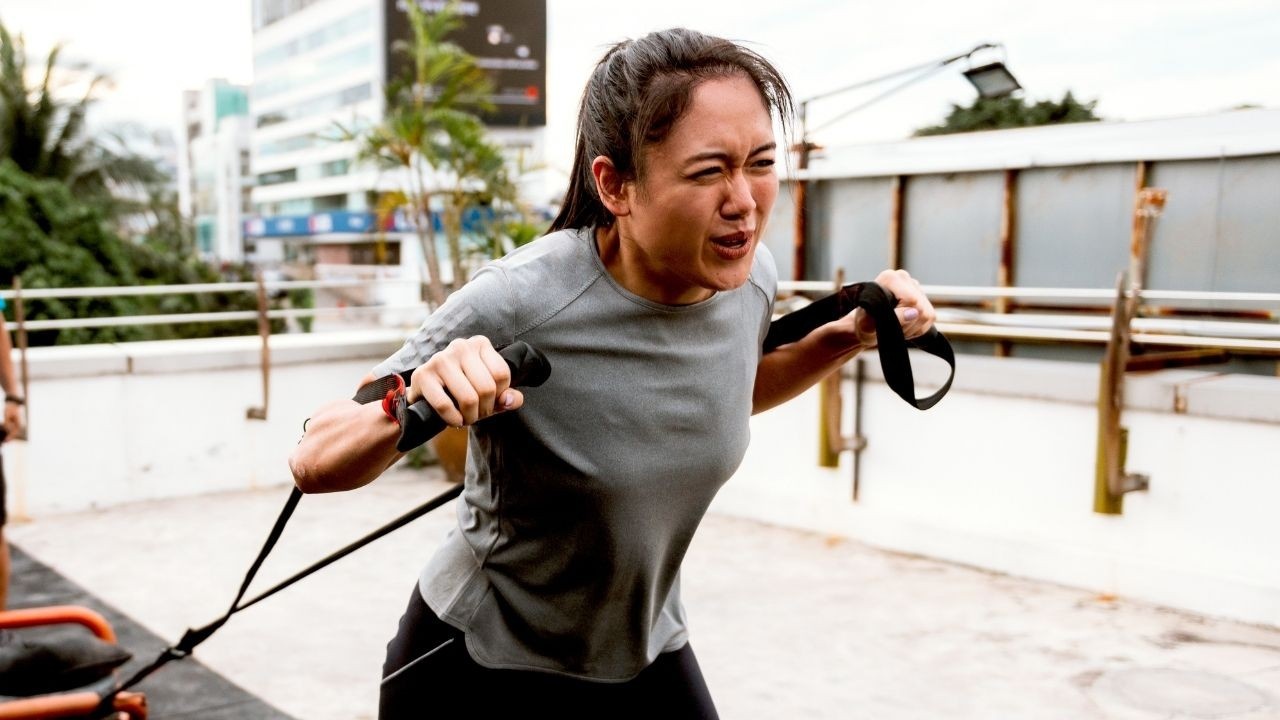May 27, 2022
Why Women in Triathlon Should Lift Heavy Sh*t Year Round

If your strength training ends when your season begins, then you are missing an opportunity to continue making gains in athletic performance – and in life.
Race season has officially begun in the northern hemisphere. As wetsuits are inspected for tears and tri suits dug out of bottom drawers, we hear familiar echoes of “where the actual f*@k is my race belt?” As a longtime coach, athlete, and mentor, I am here to give you four weeks of practical race information.
Text by Miranda Bush, Feisty Triathlon Head Coach & Educator
When I took my triathlon coaching certification courses over ten years ago, we were taught to coach athletes to “hit it hard” in the gym during the postseason, and then give up strength training entirely during the season in favor of focusing all of their time and energy on swimming, biking, and running. Coming from a personal training background, this methodology made zero sense to me. So, in the (measly) one hour committed to resistance training focus, I asked the question: If athletes got stronger but then neglected their strength practice for months, how would they ever make forward progress in power and speed application? Maintain muscle mass? Stay mobile? Prevent overuse and other injuries?
The answer? Athletes need to stay lean, not be sore, and have enough energy and time for sport-specific training.
I politely nodded, thinking “this is bulls@!t”, and continued to write plans with one to three non-negotiable strength sessions per week, depending on the athlete and training block. Thankfully, this way of thinking has long changed, with the importance of resistance training now taking center stage. The fact remains that athletes, especially women, need to maintain habits and routines that keep their bodies functioning optimally in their sport and life. That means strength training – all year round.
Why Strength Train Year-Round?
Having a stronger body directly correlates to more power and speed. Women generally have a lower proportion of type II (i.e. fast power-producing) muscle fibers than men, so hitting the weights to maintain and gain power, strength, and force is even more important. Strength training also helps you maintain your posture and balance, which benefits swim, bike, and run performance and lessens injury risk in long-distance racing (when the body fatigues).
Building your strength foundation takes time, and it quickly erodes if you stop working on it. A smart regimen starts with a lot of time and energy spent on mobility, stability, and coordination work before focusing on strength, power, and speed. Once this groundwork is laid, it is vital to establish regular training habits in order to build or maintain strength. If you neglect it for a period of time, while continuing to put your body under the same swim, bike, run, work, sitting, etc. stressors, there is a higher likelihood that you will need more time and effort spent on rebuilding your foundation.
If you don’t use it, you’ll lose it. Hormonal changes accelerate the loss of lean muscle mass. According to a 2012 study, without intervention, you can lose up to 50 percent of your lean skeletal muscle mass by your 80th birthday. Peri and post-menopausal athletes need the stimulus provided by heavy lifting to maintain muscle mass and bone integrity – year-round. But don’t wait until you reach perimenopause! Younger athletes benefit from banking muscle and strength as well as building foundational strength training habits that can then be more easily maintained through peri and post-menopause.
The benefits of regular strength work impact more than swim, bike, and run performance. Strength training helps you maintain your body composition. Yes, strength training can increase your muscle mass, but you will most likely not end up looking like a bodybuilder without a very specific training and nutrition regimen. It also positively impacts mental health and can help you sleep better. An established regular strength training routine will also benefit athletes who choose to become pregnant. Athletes will reap the above benefits while pregnant (improved stability, coordination, muscle and bone integrity, sleep quality, and mental health), and women can target postnatal weaknesses before returning to target power and speed with resumed training. Who wouldn’t want all of these benefits year-round?
The benefits of maintaining a strength regimen all year round should really speak for themselves. But, women are often short on something else that can make skipping sessions in favor of swim, bike, and run more appealing: time.
How Triathletes Can Get the Most Out of In-Season Strength Training
As a longtime coach, I still have athletes that consider strength work as “optional” (in and out of season), or generally, skip them when short on training time. There is no doubt that women are busy! Here are tips to get the most out of a regular strength training routine, even when the demands of swimming, biking, and running start to rise.
Take the guesswork out by having a professional plan. Utilize professional strength coaches, personal trainers, or physical therapists when able to create individual plans, establish limiters and imbalances by assessing your mobility, stability, and coordination, and model correct form. Pros can help you remove any “roadblocks” in your movement patterns so that you can make the most of your time spent on strength training. And if you are new, a coach/trainer can also help you avoid soreness before key races or training sessions.
Keep it simple. Vary your routine and exercises often – but to save time, and lessen injury risk, avoid overly complicated plans or moves. Get the biggest bang for your time buck by including exercises that target areas of established weakness, and/or are preventative. In women, these often include exercises that benefit hip strength and deep abdominal muscles like prone glute activation, or bird dog progressions. Lift heavy in the fundamental movements of push, pull, hinge, press, and rotary stability.
Work strength into your tri training. Plan short, high-intensity workouts coupled with strength to maintain the stimulus and tissue integrity. For example: immediately following a strength session, do a short high power effort interval session on the bike, or go for a 10-15 minute run. Alternate strength work with bike or run intervals in circuit style training. Schedule 3 X 30-minute sessions in a week, rather than 2 X 60 minutes if that works better in your schedule.
Train smarter – and that does not always mean more time in the pool, or on the road. The potential benefits of strength training are too numbered to skip the sessions in favor of more swim, bike, or run workouts. When limited on time, don’t be afraid to replace one of each triathlon sport per week with strength training. Your enhanced strength, stamina, form, decreased fatigue, and improved efficiency will make each triathlon-specific session more worth your time, and benefit your performance further (especially more than those dreaded “junk miles!”)
Women need strength training to build and maintain power and speed in triathlon. And more importantly, we need it to support our activities in daily life. Make it a priority to establish and maintain your routine all year long to continue to reap the multitude of life-changing benefits.
Resources for getting started with a strength plan:
Roar by Dr. Stacy Sims & Selene Yager
Next Level by Dr. Stacy Sims & Selene Yager
Feisty Menopause Blog: https://www.feistymenopause.com/blog/
Dr. Sims’ Blog: https://www.drstacysims.com/blog
Strength Training for Women from Triathlete: https://www.triathlete.com/training/why-men-and-women-shouldnt-follow-the-same-strength-plan/
Miranda Bush is the Head Coach and Educator at Feisty Triathlon. She is USA Triathlon and Training Peaks certified, as well as a certified Health Coach. She is also a graduate of Dr. Stacy Sim’s Women Are Not Small Men and Menopause for Athletes courses. As a longtime coach specializing in training women, her passion lies in using lessons from training and racing to teach athletes to evolve physically, mentally, and emotionally through sport. Miranda is also a longtime athlete and multiple Ironman and 70.3 distance podium finisher, maintaining a consistent racing career while working and raising her kids. She resides in Wisconsin with her three teenagers and husband who all love to race triathlon.


 Outspoken Women in Triathlon Summit Returns Bigger than Ever
Outspoken Women in Triathlon Summit Returns Bigger than Ever  Driving the Lamborghini: Productivity and the Power of Paper
Driving the Lamborghini: Productivity and the Power of Paper  5 take aways from the Compete Sports Diversity Summit
5 take aways from the Compete Sports Diversity Summit  Simple Tips to Hone Your Bike Handling Skills
Simple Tips to Hone Your Bike Handling Skills 


